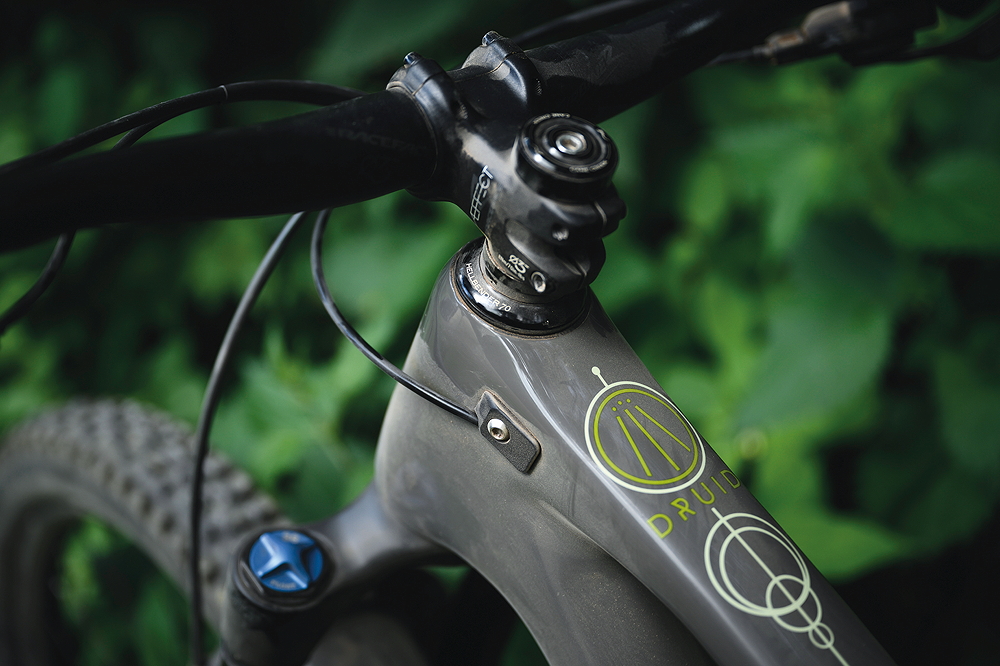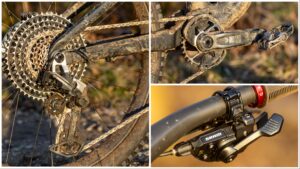The Forbidden Druid XT gulps up big hits like a basking shark, but does this high-pivot rig satiate our hunger for singletrack smash-fests?
Forbidden Druid XT review
Today, high-pivot idler bikes like this Forbidden Druid XT are rapidly becoming commonplace, especially in enduro racing. But when Forbidden launched the Druid back in 2019 it was a major departure from the norm. A statement bike to launch a fledgling brand in a crowded marketplace? Possibly. But there’s no denying that this 130mm-travel 29er trail bike with its high single-pivot suspension layout and idler garnered a lot of attention. And rightly so. But does it earn a place in the pantheon of the very best mountain bikes?

The high-pivoted Forbidden feeds on heavy hits with porcine ferocity
With its full carbon chassis the Druid masks the complexity of the frame design beautifully, the front end blending a low slung top tube and a seat mast fitting of a conning tower on a nuclear sub to maximise standover clearance. Even the linkage arrangement that actuates the shock is partially concealed, as is the shock, both helping to maintain the smooth flowing lines of the frame. Given its complexity, it’s still an easy bike to work on, as none of the bolt hardware is hidden, making it possible to remove the shock or switch to the 27.5in Ziggy link without having to remove the chainset or dismantle the frame. Yes, having the Fox DPX2 shock enclosed in a carbon tunnel makes setting the sag a little tricky, but using a 19mm template or small ruler is the easy fix for that.
In terms of geometry the Druid pushed boundaries too, with its size-specific chainstay lengths and relatively slack 64.8° head angle. And while the Druid can hardly be considered old, you could argue that the sizing is already showing its age; the size L sporting a 458mm reach, putting it more in line with most brands’ size M. In fact, with the recent introduction of the longer-travel Dreadnought, it’s clear that Forbidden has moved its sizing forward and we wouldn’t be surprised if it made the same move on the next iteration of the Druid. Thankfully, with ample standover clearance and relatively short head tubes, if you’re caught between sizes, upsizing is relatively easy, and probably recommended given that the 338mm BB isn’t that low either.

Ziggy link enables mullet compatibility
Suspension
The high single-pivot suspension layout on the Druid gives a fully rearward axle path. So even though the 440mm chainstay length sounds pretty standard, it grows as the suspension compresses to the sag position. Forbidden lists the Druid as having 130mm travel but we measured vertical wheel travel at 125mm. We don’t think for a second that Forbidden is trying to hoodwink anyone, it just measures travel along the axle path rather than vertically, hence the 5mm shortfall. The XT build comes stock with a Fox DPX2 shock and being the Performance Elite version, in addition to low-speed rebound adjustment and a three-position climb switch, you also get the low-speed compression adjuster found on the Factory units. At 80kg we ran all of the adjusters wide open, all of the time, which is a good indication that the stock shock tune is over-damped, at least for lighter riders.
Up front, the Druid rocks the latest Fox 36 Performance Elite fork so you get the Grip 2 damper with four-way adjustment and the bleed-ports of the back of the lower legs to keep everything running as smoothly as with all the best mountain bike forks. And don’t fret if you’re not a suspension wizard; guide pressures and the associated damping setting are listed on the back of the fork lowers. Travel on the 36 is 150mm, and while that sounds a lot more than on the rear, when you account for the head angle you have roughly 135mm of vertical front travel, so it’s more closely matched than you might think.

Top-end componentry finishes the Forbidden
Components
With the competitively priced XT specification on the Druid, everything is functional rather than top-end. The alloy 800mm Race Face Turbine R bar and 50mm AEffect stem make for a commanding cockpit and the SDG Radar saddle is also one of the best mountain bike saddles out there. Given the choice we would make some small changes, though. We’d like bigger rotors than the stock 180mm to improve stopping power with the XT four-piston brakes and a longer rear mudguard to better protect the shock. A less obvious upgrade would be to the DT Swiss 350 rear hub, switching the star ratchet from 18t to 36t for faster freehub engagement as there’s a distinct lag when you floor it on the Druid.

Makes the complex look simple
Forbidden Druid XT performance
Before testing the Druid we’d heard terms like magic carpet ride brandished about and most reviews say that it feels like it has more travel than claimed. Forbidden even coined the term High Pivot Witchcraft as its marketing slogan. Maybe all the hype gave us unrealistic expectations, but our first rides on the Druid left us suitably unimpressed. Yes, the bike rides flat with very little in the way of pitching, so it’s super-stable even at breakneck speeds. The suspension also feels very effective at handling drops and big single hits, so in that respect Forbidden has nailed the suspension progression.

Needs a better shock tune
Unfortunately, there’s also a distinct lack of small bump sensitivity to the rear suspension, so you feel a lot of vibration through the bike, which we initially thought was due to frame stiffness. The Druid also lacks pop, so it’s not as playful as you’d expect for a short travel rig. So maybe that’s what people mean when they say it feels like a longer travel bike? In fact, it wasn’t until we fitted the DPX2 shock from the original launch bike, with a lighter tune, that the Druid started to hint at its potential magic. But even then it was still over-damped, masking the very traits that anyone interested in a high-pivot idler bike is after.

Forbidden Druid XT, £5,999
Verdict
For a small brand Forbidden packs a mighty punch. The 130mm travel 29er Druid proving beyond a shadow of doubt that it can handle the big body blows without getting too out of shape. It’s less adept at absorbing the constant jabbing from the small hits though, which seem to really rattle its confidence and footing. With a lighter shock tune, or possibly even a coil shock, the Druid may live up to the high pivot hype, but as it stands it seems like a sluggish heavyweight banking on delivering one knockout blow, while lighter, less complex designs dance rings around it.
















